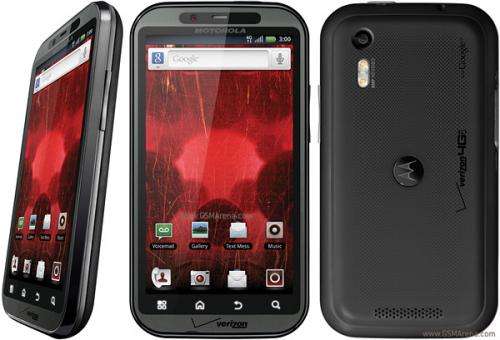Droid Bionic smartphone from Verizon finally lands -- and it's a winner

With the Droid Bionic, Verizon is finally delivering on a promise it made more than eight months ago.
That's when Verizon first showed off the smartphone to journalists at the International Consumer Electronics Show in Las Vegas, saying it would be among four 4G phones the carrier would release in the first half of this year.
The other three phones-the HTC ThunderBolt, LG Revolution and Droid Charge-hit that mark. The Droid Bionic did not.
After months of delays, the Droid Bionic is now available from Verizon for $300 with a two-year contract agreement.
I've been using the Bionic for about a week and it's easily the best phone I've used all year.
The Bionic has undergone a number of revisions since I first got my hands on it at CES, including a case redesign that has made the corners a bit less rounded. It has also gotten noticeably thinner.
The phone that finally hit store shelves is a sleek and solid piece of hardware that is the first phone to run on Verizon's screaming fast 4G LTE network and also have a dual-core processor.
SOLID HARDWARE
The Droid Bionic has an 8-megapixel camera and captures 1080p high-definition video.
The image quality here was decent-on par with other top smartphone offerings.
It comes with 16 GB of internal storage and a 16 GB microSD card, which is expandable up to 32 GB for a total of 48 GB.
The $300 price point pits it against the top-tier iPhone, which also has 32 GB of total storage.
The Bionic features a mobile hotspot function, allowing users to share the 4G data connection with up to five devices over WiFi.
Monthly plans for the Bionic start at $70 a month for 450 minutes of talk time and 2 GB of data. The mobile hotspot functionality can be turned on for $30 more a month and an additional 2 GB of data.
In just a week of heavy use of the Bionic, I amassed nearly 6 GB of data usage, so customers will have to be careful how much data they use with the fast 4G connection. It's now easier to use a lot more data.
SOFTWARE QUIRKS
The Droid Bionic runs Android 2.3 (Gingerbread) and comes with an attractive set of homescreen widgets from Motorola.
The Web browser on the Droid Bionic is snappy, especially on the 4G network. Playing Flash videos offered no issues.
As is the case with all new Android phones, compatible apps are a bit hit and miss.
The Droid Bionic does support Netflix video streaming, but video calling inside the Skype app did not work in my tests. Skype has gradually been supporting video calling on Android-based phones, so expect the Bionic to see that feature through a software update soon.
Hulu Plus is also not available.
The Bionic includes a Motorola-built program called ZumoCast that allows users to stream music, videos, pictures and documents stored on a personal computer to the phone.
Gmail email messages on the Bionic are still relegated to a standalone app separate from other email accounts - a maddening Android quirk that has been around since the very beginning.
BATTERY FARES WELL
The battery tests on the Droid Bionic offered some promising results.
While performing a continuous streaming video test over WiFi with the screen set to 75% brightness-brighter than the recommended setting-I was able to get just shy of five hours of battery life. That's a great mark.
The battery lasted almost three hours when the phone was used continually as a WiFi hotspot and connected to my Apple iPad and laptop, which then used Verizon's superfast 4G LTE network to connect to the Web.
Also good: The battery took just more than two hours to fully recharge. This isn't a phone that spends as much time plugged in as it does being used.
Remember that these tests are meant to quickly drain the battery in continuous use conditions. In real-life use, the Droid Bionic will last comfortably from morning until night.
PRESENTATION LACKS
The Droid phones from Motorola haven't been helped by marketing that has portrayed them as soulless machines.
The personality that Motorola has built into the Bionic is apparently a baritone cyborg. Turn it on and you'll hear the characteristic, and offputting, "Drooooooooid" proclamation as the phone boots up.
It comes in a futuristic, metallic-looking package. Its full set of default backgrounds make the phone look like a bright red circuit board - not exactly the most approachable of devices.
There is no denying the incredible power packed inside the Droid Bionic.
But much of the attraction to the iPhone is its universal appeal. It's a device that quietly fits seamlessly into our digital lives.
Apple doesn't even tell customers how fast the iPhone's processor speed is or how much RAM is packed inside. Phones like the Droid Bionic lead with proclamations about processor speed and power.
Android-a software platform that has become incredibly polished and mainstream this year-deserves better.
Most customers aren't won by fact sheets that list things like dual-core processors or HDMI connectivity. They don't want a machine or tool. They want a piece of the magic that has sent the iPhone to the top of buyers' wish lists.
The Droid Bionic has that, if you can wade through all the cold packaging.
It's an undeniably great phone, powered by the fastest wireless network in the air today.
For those who have been waiting out the 4G smartphone race this summer, hoping for a hit with the Bionic, your wait has been rewarded. This one is worth buying.
(c)2011 the Detroit Free Press
Distributed by MCT Information Services





















